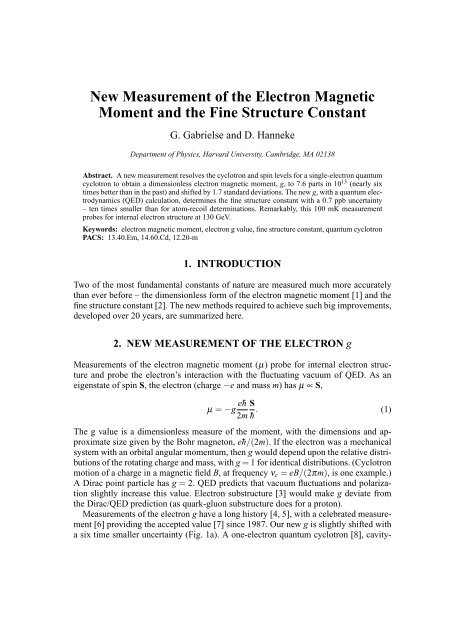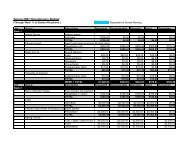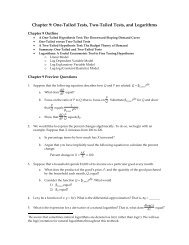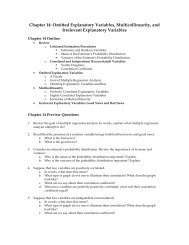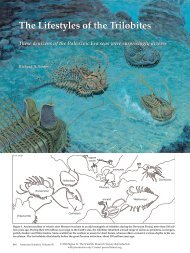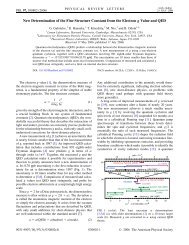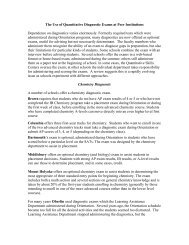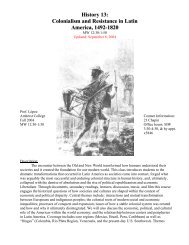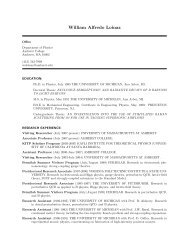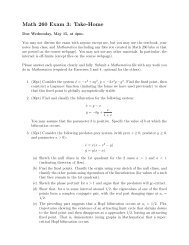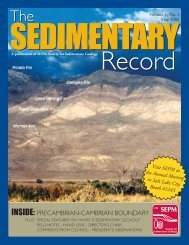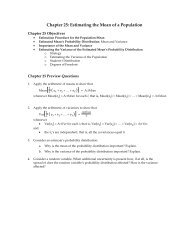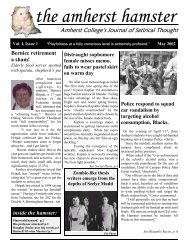New Measurement of the Electron Magnetic Moment and the Fine ...
New Measurement of the Electron Magnetic Moment and the Fine ...
New Measurement of the Electron Magnetic Moment and the Fine ...
You also want an ePaper? Increase the reach of your titles
YUMPU automatically turns print PDFs into web optimized ePapers that Google loves.
<strong>New</strong> <strong>Measurement</strong> <strong>of</strong> <strong>the</strong> <strong>Electron</strong> <strong>Magnetic</strong><br />
<strong>Moment</strong> <strong>and</strong> <strong>the</strong> <strong>Fine</strong> Structure Constant<br />
G. Gabrielse <strong>and</strong> D. Hanneke<br />
Department <strong>of</strong> Physics, Harvard University, Cambridge, MA 02138<br />
Abstract. A new measurement resolves <strong>the</strong> cyclotron <strong>and</strong> spin levels for a single-electron quantum<br />
cyclotron to obtain a dimensionless electron magnetic moment, g, to 7.6 parts in 10 13 (nearly six<br />
times better than in <strong>the</strong> past) <strong>and</strong> shifted by 1.7 st<strong>and</strong>ard deviations. The new g, with a quantum electrodynamics<br />
(QED) calculation, determines <strong>the</strong> fine structure constant with a 0.7 ppb uncertainty<br />
– ten times smaller than for atom-recoil determinations. Remarkably, this 100 mK measurement<br />
probes for internal electron structure at 130 GeV.<br />
Keywords: electron magnetic moment, electron g value, fine structure constant, quantum cyclotron<br />
PACS: 13.40.Em, 14.60.Cd, 12.20-m<br />
1. INTRODUCTION<br />
Two <strong>of</strong> <strong>the</strong> most fundamental constants <strong>of</strong> nature are measured much more accurately<br />
than ever before – <strong>the</strong> dimensionless form <strong>of</strong> <strong>the</strong> electron magnetic moment [1] <strong>and</strong> <strong>the</strong><br />
fine structure constant [2]. The new methods required to achieve such big improvements,<br />
developed over 20 years, are summarized here.<br />
2. NEW MEASUREMENT OF THE ELECTRON g<br />
<strong>Measurement</strong>s <strong>of</strong> <strong>the</strong> electron magnetic moment (µ) probe for internal electron structure<br />
<strong>and</strong> probe <strong>the</strong> electron’s interaction with <strong>the</strong> fluctuating vacuum <strong>of</strong> QED. As an<br />
eigenstate <strong>of</strong> spin S, <strong>the</strong> electron (charge −e <strong>and</strong> mass m) has µ ∝ S,<br />
µ = −g e¯h S<br />
2m ¯h . (1)<br />
The g value is a dimensionless measure <strong>of</strong> <strong>the</strong> moment, with <strong>the</strong> dimensions <strong>and</strong> approximate<br />
size given by <strong>the</strong> Bohr magneton, e¯h/(2m). If <strong>the</strong> electron was a mechanical<br />
system with an orbital angular momentum, <strong>the</strong>n g would depend upon <strong>the</strong> relative distributions<br />
<strong>of</strong> <strong>the</strong> rotating charge <strong>and</strong> mass, with g = 1 for identical distributions. (Cyclotron<br />
motion <strong>of</strong> a charge in a magnetic field B, at frequency ν c = eB/(2πm), is one example.)<br />
A Dirac point particle has g = 2. QED predicts that vacuum fluctuations <strong>and</strong> polarization<br />
slightly increase this value. <strong>Electron</strong> substructure [3] would make g deviate from<br />
<strong>the</strong> Dirac/QED prediction (as quark-gluon substructure does for a proton).<br />
<strong>Measurement</strong>s <strong>of</strong> <strong>the</strong> electron g have a long history [4, 5], with a celebrated measurement<br />
[6] providing <strong>the</strong> accepted value [7] since 1987. Our new g is slightly shifted with<br />
a six time smaller uncertainty (Fig. 1a). A one-electron quantum cyclotron [8], cavity-
inhibited spontaneous emission [9], a self-excited oscillator (SEO) [10], <strong>and</strong> a cylindrical<br />
Penning trap [11] contribute to <strong>the</strong> extremely high precision. For <strong>the</strong> first time,<br />
<strong>the</strong> lowest cyclotron <strong>and</strong> spin levels <strong>of</strong> a single electron are fully resolved via quantum<br />
non-demolition (QND) measurements [8], <strong>and</strong> a cavity shift <strong>of</strong> g is directly observed.<br />
(a)<br />
ppt = 10 -12<br />
0 5 10<br />
(b)<br />
ppb = 10 -9<br />
-15 -10 -5 0 5 10<br />
Harvard (2006)<br />
UW (1987)<br />
180 185 190<br />
Rb (2006)<br />
(g / 2 - 1.001 159 652 000) / 10 -12<br />
CODATA 2002<br />
7.5 8.0 8.5 9.0 9.5 10.0 10.5 11.0<br />
(α -1 - 137.035 990) / 10 -6<br />
Harvard g (2006)<br />
Cs (2006)<br />
UW g (1987)<br />
FIGURE 1. Six-fold improved electron g is 1.7 st<strong>and</strong>ard deviations from <strong>the</strong> last measurement (a). <strong>New</strong><br />
α is ten times less uncertain than values <strong>of</strong> α deduced from Rb <strong>and</strong> Cs [12, 13], <strong>and</strong> <strong>the</strong> current CODATA<br />
value [7] (b). Measured g are converted to α with current QED <strong>the</strong>ory.<br />
What can be learned from a more accurate electron g The first result beyond g<br />
itself is a shifted <strong>and</strong> much less uncertain value for <strong>the</strong> fine structure constant, α =<br />
e 2 /(4πε 0¯hc) [2] – about ten times more accurate than nearest rival methods. This<br />
is <strong>the</strong> first uncertainty reduction since 1987 in this measure <strong>of</strong> <strong>the</strong> strength <strong>of</strong> <strong>the</strong><br />
electromagnetic interaction, a crucial ingredient in our system <strong>of</strong> fundamental constants<br />
[7]. Second, <strong>the</strong> most stringent test <strong>of</strong> QED <strong>the</strong>ory is provided, limited by ten times larger<br />
uncertainties in independent measurements <strong>of</strong> α. Third, even though muon g values have<br />
nearly 1000 times larger uncertainties [14], <strong>the</strong> muon <strong>and</strong> electron g values toge<strong>the</strong>r are<br />
a sensitive probe for physics beyond <strong>the</strong> st<strong>and</strong>ard model. Calculations <strong>of</strong> <strong>the</strong> muon g<br />
depends more sensitively upon heavy particles, as well as upon α, which <strong>the</strong> electron g<br />
provides.<br />
3. BIG IMPROVEMENT REQUIRES NEW METHODS<br />
One electron suspended in a Penning trap is used for <strong>the</strong> new measurement, like in past.<br />
However, methods developed for <strong>the</strong> new measurement over 20 years (<strong>and</strong> reported<br />
in 6.5 Ph.D. <strong>the</strong>ses) make it possible to realize an electron that resides entirely in<br />
<strong>the</strong> quantum ground state <strong>of</strong> its cyclotron motion. This “quantum cyclotron” leaves<br />
its ground state only when we deliberately send a resonant photon to excite it. The<br />
homemade “atom” that we make for <strong>the</strong> measurement is now essentially quantum<br />
mechanical ra<strong>the</strong>r than classical.<br />
1. Only <strong>the</strong> lowest quantum levels <strong>of</strong> <strong>the</strong> spin <strong>and</strong> cyclotron motion are used for <strong>the</strong><br />
measurement. The cyclotron frequency, as well as <strong>the</strong> spin frequency, is measured<br />
using quantum jump spectroscopy.<br />
2. A Penning trap that is also a microwave cavity is used to control <strong>the</strong> radiation field.<br />
It can suppress spontaneous emission from <strong>the</strong> cyclotron motion by more than a<br />
factor <strong>of</strong> 100, giving us <strong>the</strong> averaging time that we need to resolve one quantum<br />
transitions.<br />
3. The microwave cavity is an underst<strong>and</strong>able, right circular cylinder, which makes it<br />
possible to identify <strong>the</strong> its electromagnetic modes when <strong>the</strong>se are measured in situ
with a method developed for this. This allows us underst<strong>and</strong>, measure <strong>and</strong> control<br />
cavity shifts for <strong>the</strong> first time.<br />
4. The trap cavity is at 0.1 mK (ra<strong>the</strong>r than 4.2 K in <strong>the</strong> past). This eliminates<br />
blackbody photons that would frequency excite <strong>the</strong> cyclotron ground state.<br />
5. Great signal-to-noise for one-quantum transitions is obtained using electronic feedback<br />
to realize <strong>the</strong> first one-particle self-excited oscillator.<br />
The new methods are powerful enough that we now aspire to a million-times-improved<br />
measurement <strong>of</strong> <strong>the</strong> antiproton magnetic moment [10] – a moment that is about 500<br />
times smaller than that <strong>of</strong> <strong>the</strong> electron.<br />
(a)<br />
trap cavity electron<br />
top endcap<br />
electrode<br />
quartz spacer<br />
compensation<br />
electrode<br />
ring electrode<br />
nickel rings<br />
0.5 cm<br />
compensation<br />
electrode<br />
bottom endcap<br />
field emission point electrode<br />
(b)<br />
n = 2<br />
n = 1<br />
n = 0<br />
ν c<br />
- 3δ / 2<br />
ν c<br />
- δ / 2<br />
m s = -1/2 m s = 1/2<br />
n = 1<br />
f c<br />
= ν c<br />
- 3δ / 2<br />
n = 0<br />
ν a<br />
= gν c<br />
/ 2 − ν c<br />
FIGURE 2. Cylindrical Penning trap cavity used to confine a single electron <strong>and</strong> inhibit spontaneous<br />
emission (a), <strong>and</strong> <strong>the</strong> cyclotron <strong>and</strong> spin levels <strong>of</strong> an electron confined within it (b).<br />
The electron is suspended in a cylindrical Penning trap (Fig. 2a) [11]. The electron<br />
starts in one <strong>of</strong> <strong>the</strong> two lowest <strong>of</strong> <strong>the</strong> cyclotron <strong>and</strong> spin levels (Fig. 2b), <strong>the</strong> cyclotron<br />
levels being slightly modified (in a well understood <strong>and</strong> completely measurable way) by<br />
<strong>the</strong> trap potentials <strong>and</strong> δ comes from special relativity. Feedback is used to produce a<br />
one-electron self-excited oscillator [10] which serves as a detector for one quantum cyclotron<br />
<strong>and</strong> spin transitions, with a spin flip (Fig. 3a) <strong>and</strong> a cyclotron transition (Fig. 3b)<br />
clearly resolved [8, 10]. Quantum jump spectroscopy (measuring <strong>the</strong> quantum jumps per<br />
attempt to drive <strong>the</strong>m as a function <strong>of</strong> drive frequency) gives resonance lineshapes for<br />
<strong>the</strong> cyclotron frequency ¯f c (Fig. 3c) <strong>and</strong> <strong>the</strong> anomaly frequency ¯ν a (Fig. 3d). The line<br />
shape comes from <strong>the</strong>rmal axial motion within a magnetic bottle gradient [15].<br />
ν z shift<br />
in ppb<br />
20<br />
10<br />
0<br />
(a)<br />
0 20 40 60<br />
time (s)<br />
(b)<br />
0 20 40 60<br />
time (s)<br />
quantum jump fraction<br />
0.20<br />
0.15<br />
0.10<br />
0.05<br />
0.00<br />
(c)<br />
-1 0 1 2<br />
frequency - ν a in Hz<br />
1 ppb 1 ppb<br />
0 1<br />
frequency - f c in kHz<br />
(d)<br />
FIGURE 3. Sample ¯ν z shifts for a spin flip (a) <strong>and</strong> for a one-quantum cyclotron excitation (b). Quantum<br />
jump spectroscopy lineshapes for anomaly (c) <strong>and</strong> cyclotron (d) transitions, with a maximum likelihood<br />
fit to <strong>the</strong> calculated lineshapes (solid). The b<strong>and</strong>s indicate 68% confidence limits for distributions <strong>of</strong><br />
measurements about <strong>the</strong> fit values.
The electron g is deduced from <strong>the</strong> anomaly <strong>and</strong> spin-up cyclotron frequencies ( ¯ν a ≈<br />
173 MHz <strong>and</strong> ¯f c in Fig. 2b) using<br />
g<br />
2 = ¯ν c + ¯ν a<br />
ν c<br />
≃ 1 +<br />
¯ν a − ¯ν 2 z /(2 ¯f c )<br />
¯f c + 3δ/2 + ¯ν 2 z /(2 ¯f c ) , (2)<br />
where ¯ν z is <strong>the</strong> measured frequency <strong>of</strong> <strong>the</strong> electron’s harmonic oscillation along <strong>the</strong><br />
magnetic field direction. The new value for <strong>the</strong> electron magnetic moment is given by<br />
g/2 = 1.00115965218085(76) (0.76 ppt). (3)<br />
The st<strong>and</strong>ard deviation, about six times smaller than from any previous measurement,<br />
arises mostly from an imperfect lineshape model <strong>and</strong> cavity shifts.<br />
4. DETERMINATION OF THE FINE STRUCTURE CONSTANT<br />
The new electron g, toge<strong>the</strong>r with QED <strong>the</strong>ory, determine <strong>the</strong> fine structure constant,<br />
α, about ten times more accurately than does any rival method. QED provides an<br />
asymptotic series relating g <strong>and</strong> α,<br />
g<br />
( α<br />
) ( α<br />
) 2 ( α<br />
) 3 ( α<br />
) 4<br />
2 = 1 + C 2 +C 4 +C6 +C8<br />
π π π π<br />
+ ... + a µτ + a hadronic + a weak , (4)<br />
with hadronic <strong>and</strong> weak contributions added, <strong>and</strong> assuming no electron substructure.<br />
Impressive calculations, summarized in [2], give exact C 2 , C 4 <strong>and</strong> C 6 , a numerical value<br />
<strong>and</strong> uncertainty for C 8 , <strong>and</strong> a small a µτ .<br />
Our new value for α [2] comes from <strong>the</strong> measured g <strong>and</strong> Eq. 4,<br />
α −1 = 137.035999710(90)(33) [0.66 ppb][0.24 ppb],<br />
= 137.035999710(96) [0.70 ppb], (5)<br />
The first line gives <strong>the</strong> experimental uncertainty first <strong>and</strong> <strong>the</strong> QED uncertainty second,<br />
including an estimated contribution from a yet uncalculated C 10 [2]. The total 0.70<br />
ppb uncertainty is ten times smaller than for <strong>the</strong> next most precise methods (Fig. 1b)<br />
– determining α from measured mass ratios, optical frequencies, toge<strong>the</strong>r with ei<strong>the</strong>r<br />
Rb [12] or Cs [13] recoil velocities.<br />
5. TESTING QED, AND PROBING ELECTRON STRUCTURE<br />
The most stringent test <strong>of</strong> QED (one <strong>of</strong> <strong>the</strong> most dem<strong>and</strong>ing comparisons <strong>of</strong> any calculation<br />
<strong>and</strong> experiment) comes from comparing <strong>the</strong> measured <strong>and</strong> calculated g/2. The new<br />
g, toge<strong>the</strong>r with α(Cs) or α(Rb) in Eq. 4, give a difference |δg/2| < 15 × 10 −12 . The<br />
small uncertainties in g/2 will allow a ten times more stringent test if ever <strong>the</strong> large uncertainties<br />
in <strong>the</strong> independent α values can be reduced. The prototype <strong>of</strong> modern physics<br />
<strong>the</strong>ories is thus tested far more stringently than its inventors could ever have envisioned.
The same comparison <strong>of</strong> <strong>the</strong>ory <strong>and</strong> experiment probes <strong>the</strong> internal structure <strong>of</strong><br />
<strong>the</strong> electron [3] – limiting <strong>the</strong> electron to constituents with a mass m ∗ ≥ m/δg/2 =<br />
34,000 TeV/c 2 , with an electron radius R < 6 × 10 −24 m. If this test was limited only<br />
by our experimental uncertainty in g, <strong>the</strong>n we could set a limit m ∗ > 600 GeV. These<br />
high energy limits seem somewhat remarkable for an experiment carried out at 100 mK.<br />
6. CONCLUSION<br />
In conclusion, greatly improved measurements <strong>of</strong> <strong>the</strong> electron magnetic moment <strong>and</strong> <strong>the</strong><br />
fine structure constant, <strong>and</strong> a sensitive probe for internal electron structure, come from<br />
resolving <strong>the</strong> lowest cyclotron <strong>and</strong> spin levels <strong>of</strong> a one-electron quantum cyclotron. A<br />
self-excited oscillation <strong>of</strong> <strong>the</strong> electron reveals one-quantum transitions. A cylindrical<br />
Penning trap cavity narrows resonance lines by inhibiting spontaneous emission. Electromagnetic<br />
modes <strong>of</strong> this underst<strong>and</strong>able cavity geometry, probed with synchronized<br />
electrons, shift g in a measurable way. The new g/2 is shifted from a long accepted<br />
value by 1.7 st<strong>and</strong>ard deviations, <strong>and</strong> its fractional accuracy <strong>of</strong> 7.6 × 10 −13 is nearly six<br />
times smaller. The new α has an uncertainty ten times smaller than that from any o<strong>the</strong>r<br />
determination.<br />
The <strong>the</strong>ses <strong>of</strong> B. D’Urso [16] <strong>and</strong> B. Odom [17] give many measurement details, <strong>and</strong><br />
a preliminary analysis is in <strong>the</strong> latter. S. Peil, D. Enzer, <strong>and</strong> K. Abdullah contributed to<br />
earlier versions <strong>of</strong> <strong>the</strong> apparatus. The NSF AMO program provided long-term funding.<br />
REFERENCES<br />
1. B. Odom, D. Hanneke, B. D’Urso, <strong>and</strong> G. Gabrielse, Phys. Rev. Lett. 97, 030801 (2006).<br />
2. G. Gabrielse, D. Hanneke, T. Kinoshita, M. Nio, <strong>and</strong> B. Odom, Phys. Rev. Lett. 97, 030802 (2006).<br />
3. S. J. Brodsky, <strong>and</strong> S. D. Drell, Phys. Rev. D 22, 2236 – 2243 (1980).<br />
4. A. Rich, <strong>and</strong> J. C. Wesley, Rev. Mod. Phys. 44, 250 (1972).<br />
5. R. S. Van Dyck Jr. , P. B. Schwinberg, <strong>and</strong> H. G. Dehmelt, The <strong>Electron</strong>, Kluwer Academic Publishers,<br />
Ne<strong>the</strong>rl<strong>and</strong>s, 1991.<br />
6. R. S. Van Dyck, Jr., P. B. Schwinberg, <strong>and</strong> H. G. Dehmelt, Phys. Rev. Lett. 59, 26–29 (1987).<br />
7. P. J. Mohr, <strong>and</strong> B. N. Taylor, Rev. Mod. Phys. 72, 377 (2000), Rev. Mod. Phys. 77, 18 (2005).<br />
8. S. Peil, <strong>and</strong> G. Gabrielse, Phys. Rev. Lett. 83, 1287–1290 (1999).<br />
9. G. Gabrielse, <strong>and</strong> H. Dehmelt, Phys. Rev. Lett. 55, 67–70 (1985).<br />
10. B. D’Urso, R. Van H<strong>and</strong>el, B. Odom, D. Hanneke, <strong>and</strong> G. Gabrielse, Phys. Rev. Lett. 94, 113002<br />
(2005).<br />
11. G. Gabrielse, <strong>and</strong> F. C. MacKintosh, Intl. J. <strong>of</strong> Mass Spec. <strong>and</strong> Ion Proc. 57, 1–17 (1984).<br />
12. P. Cladé, E. de Mir<strong>and</strong>es, M. Cadoret, S. Guellati-Khélifa, C. Schwob, F. Nez, L. Julien, <strong>and</strong><br />
F. Biraben, Phys. Rev. Lett. 96, 033001 (2006).<br />
13. V. Gerginov, K. Calkins, C. E. Tanner, J. McFerran, S. Diddams, A. Bartels, <strong>and</strong> L. Hollberg, Phys.<br />
Rev. A 73, 032504 (2006).<br />
14. G. W. Bennett, et al., Phys. Rev. Lett. 92, 161802 (2004).<br />
15. L. S. Brown, Ann. Phys. (N.Y.) 159, 62–98 (1985).<br />
16. B. D’Urso, Cooling <strong>and</strong> Self-Excitation <strong>of</strong> a One-<strong>Electron</strong> Oscillator, Ph.D. <strong>the</strong>sis, Harvard Univ.<br />
(2003).<br />
17. B. Odom, Fully Quantum <strong>Measurement</strong> <strong>of</strong> <strong>the</strong> <strong>Electron</strong> <strong>Magnetic</strong> <strong>Moment</strong>, Ph.D. <strong>the</strong>sis, Harvard<br />
University (2004).


